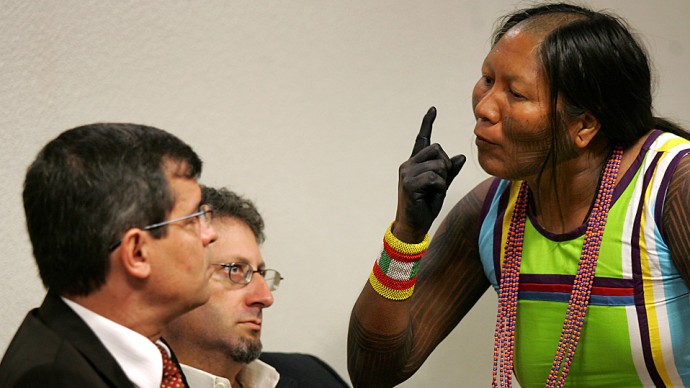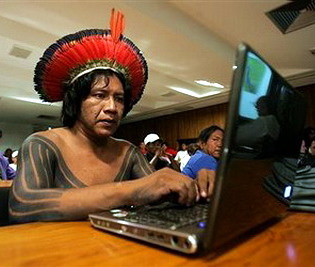
(MintPress)—”We used to defend our selves by bow and arrow. But that doesn’t work anymore. Our modern weapon is the internet,” says Benki Piyako, the son of the chief of the Ashaninka in the Brazilian rainforest. “This is the only way to ensure safety on our territory.”
Piyako’s homeland is the Amazon rainforest, on the border of Brazil and Peru. This area has been where the Ashaninka people have lived since being forcibly removed from their ancestral lands in Peru decades ago. And now, they’re under attack yet again.
Piyako and his people are waging a battle against illegal loggers, who come on to the tribe’s protected land and pillage its resources, killing and threatening villagers who get into their way.
Lush, green canopies of fertile forests were once what one could spy from an aerial position.
But now, as documented in a new film, The Internet Indians by Ilka Franzmann, large brown swaths of deforested land, and a few sickly, forgotten trees are all that remain of the once breathtaking and life-giving landscape.
The Struggle Today
Today the tribe is engaged in a fight to conserve biodiversity and protect their land and people.
Rainforests once covered 14 percent of the earth’s land surface; now they cover a mere 6 percent, according to information provided by Raintree. Experts estimate that the last remaining rainforests could be consumed in less than 40 years.
While the land the tribe inhabits is protected from deforestation stemming from a 2000 government decree, in September of 2001 Ashaninka communities denounced an ongoing invasion of “clandestine Peruvian loggers” on territory in the state of Acre, Brazil.
The denunciation followed a four-day inspection of the territory by tribal officials, and well documented in media reports, which revealed that loggers were actively harvesting mahogany and cedar, two endangered hardwoods that are protected by law.
Problems intensified for the tribe in 2002, when the Peruvian government “granted immense areas of forest [through a new forest law] to large scale logging companies. Without due inspection, the policy [has facilitated] the illegal activities, which invade the native community areas,” according to one source.
One Ashéninka Indian was quoted by non-profit Survival International as saying, ‘What we are most worried about is that the authorities have not yet fulfilled their responsibilities. If they don’t solve the problem, our territory will continue to be invaded, and we will continue to receive death threats’.
Deforestation is a major problem for them because they depend on the forest for their food and shelter; they cannot survive without it.
But everyone on the planet has cause for concern, as the Amazon Rainforest has been described as the “Lungs of our Planet” because it provides the essential environmental world service of continuously recycling carbon dioxide into oxygen. More than 20 percent of the world’s oxygen is produced in the Amazon Rainforest.
Piyako admitted in the film, “I’ve been threatened several times …. The attacks began when we tried to prevent their logging. The woodcutters felt their livelihood was threatened. As if we were taking something away from them.”
Taking the Fight Online
However, the threats ebbed a few years ago when a Brazilian NGO, Thydewa, started equipping isolated indigenous communities with internet stations. Thydewa’s goal is to use the web, mobile phones, and pocket cameras as tools to help Brazil’s indigenous people defend the lands and identities.
Thanks to Thydewa the tribe has been the first in the Amazon to be outfitted with internet access, which they use to call in the military and the United Nations to help protect their lands when threats ensue.
As AlJazeera reported, “This gave a significant boost to the fight for the rights of the indigenous population, and the Ashaninka in particular made headlines because they are a living example of how to combine traditions with modernity and responsibility for the environment.”
A People Known for Bravery and Independence
The Asháninka were known by the invading Spanish Conquistadors in the fifteenth century to be fiercely independent, and were noted for their “bravery and independence”.
They strongly resisted outside influence for much of their people’s history, holding on to their culture and traditions.
Since the 1950s, however, Asháninka territories have been reduced and their settlements have been systematically destroyed, resulting in a retreat by Asháninka people into the jungle.
And as recently as the 1980s and 1990s, internal conflicts in Peru caused massive displacement, disappearance, and spelled death for many of the Asháninka people.
During this dark period, much of their land was burned, Asháninka legal papers were destroyed, and some Asháninka were made to join the Shining Path, a Maoist guerrilla insurgent organization in Peru, on pain of death.
Ten thousand Asháninka were displaced, another six thousand Asháninka died, and five thousand Asháninka were taken captive by the Shining Path during this time. As a result, thirty to forty Asháninka communities disappeared, according to the Truth and Reconciliation Committee.
Today the Asháninka number only about the size of an American town, with between 25,000 and 45,000 people.
As Dr. José Pimenta, a professor of archaeology with the University of Brasilia points out, “The Ashaninka have a long history of resistance, standing up to invaders since the time of the Inca empire until the rubber boom of the nineteenth century and, especially those on the Brazilian side of the border, resisting the encroaches of loggers from the 1980s to today. A people proud of their culture, driven by strong sense of freedom, ready to die in defence of their territory, the Ashaninka are no mere objects of western history. They possess an astonishing capacity to reconcile traditional customs and values with ideas and practices from the western world, such as those to do with socio-environmental sustainability.”
Piyako wants all Amazonian tribes to be given internet access. He says, “ We know that the internet can save us from attacks. It is an important means of defending our indigenous population.”
Meanwhile, while Piyako stands poised, fingers ready to click the send button and fire an email off from his laptop when the next gang of logging thugs crops up, one and one-half acres of rainforest are lost every second with tragic consequences for both developing and industrial countries.


